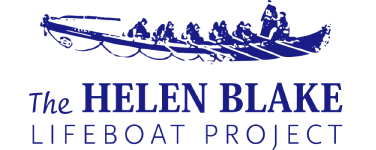The Helen Blake
The Tragedy
The Benefactor
The Fethard Lifeboat Crew by Matty Barden
The Tragedy
Every year since it was founded in 1824, the RNLI has relied on volunteers to crew its lifeboats with virtually every occupation and profession represented. And it was no different on that fateful day when the farmers and fishermen who made up the crew of the Helen Blake, set out from Fethard-on-Sea in County Wexford on a rescue mission that, sadly, would make history.
Around mid-day on the 20th February 1914, the Norwegian three-masted schooner, the ‘Mexico’, was 20 miles off Hook Head, battling its way through gale force winds on the last leg of a 5000 mile journey from South America. Visibility was almost zero, the weather was atrocious, and the winds were getting worse. The captain was left with very little choice but to run for shelter, but even that wasn’t possible, and she was driven further south by the wind. Just a few hours later, the Mexico was aground on the rocks surrounding the Keeragh Islands in Ballyteigue Bay.
On shore, news of the disaster was relayed to Fethard, the alarm was raised and the men who formed the lifeboat crew made their way from their homes and workplaces to the boathouse to set out on a rescue attempt that would end in tragedy. When it was all over, just 5 of the 14 man crew returned to their homes.
What they did that day is almost unbelievable – a cold winter’s day, rain was lashing down, the wind was blowing so hard it was an effort to stand straight, at sea the waves were so high the view beyond them was totally obscured and in the midst of all this, fourteen brave men launched a 35 foot rowing boat to fight their way through three miles of wind and waves, putting their own lives at risk, to save the lives of people they didn’t even know. Statistics say nine crewmen lost their lives that day, but in Fethard-on-Sea, it is seen as far more than that.
These were nine of our fellow villagers, nine individuals, nine people snatched away in the prime of their lives leaving behind grieving family members and three widows with sixteen children who would grow up without a father. And it’s not just those who lost their lives; the remaining crewmen, and those whose lives they had saved, spent three days and nights on the Keeraghs in appalling weather, with no shelter, food or water. It was during this time that a young crew member of the Mexico died and was buried in a shallow grave.
It took the combined effort of three lifeboats: The Sisters from Kilmore, the Fanny Harriet from Dunmore and the James Stevens from Rosslare, together with the Wexford tugboat, before they could themselves be rescued.
It is those men, those heroes, that their descendants and fellow villagers want to honour by building a replica of their boat that will be a lasting memory and a fitting tribute to their selfless bravery.
Those who gave their lives
Patrick Stafford
The Survivors

The Benefactor
When Michael and Mary Sheridan’s daughter, Helen, was born in Claremorris, County Mayo, in 1800, they could have had no idea that she would one day become a lady in Georgian and Victorian Britain, or that her name would live on hundreds of years later in the village of Fethard-on-Sea in County Wexford.
Helen was still a young teenager when she was sent by her schoolteacher father to work with his brother who was the proprietor of Tyrawley hotel in nearby Castlebar. She was just 18 when she met a British army officer more than twice her age who was staying at the hotel. Captain Robert Dudley Blake, like most officers of that era, was from the wealthy landed gentry; his father, Sir Francis Blake, had been appointed High Sheriff of Northumberland by King George III.
The unlikely couple of British officer and Irish country girl fell in love but such a union would have been frowned upon in the locality so their only option was to elope. Reports say they were pursued by Helen’s father and uncle from Castlebar to Ballyglass and on to Tuam in neighbouring County Galway. Love won out, however, and they eventually made it across the country and on to Scotland where, in 1819, they married before moving to Handcross Hall in Cuckfield, Sussex.
Robert decided that Helen should attend a fashionable boarding school in London where she not only completed her education, but also learned the ways of the British upper classes and thus qualified to mingle with the wives of other officers in her husband’s regiment. The couple were very well known, and very active, in the social circles of London and their marriage was a singularly happy one, punctuated with a great sadness when their only child died in infancy.
Robert progressed well in his military career and by the time of his death, in March 1850, he had been promoted to General. There was some consternation when his will was published to find he had left his entire estate to Helen, excluding his family from any inheritance, and this was added to a month later when Robert’s brother, Francis, died and also left a sizeable portion of his estate to Helen.
After over thirty years of marriage, Robert’s death hit Helen very hard and she moved out of their beloved Handcross Hall to a smaller and more manageable house at 4 Earls Terrace in Kensington where she led a quiet life until her death in September 1876. At her request, she was buried alongside her husband in Norham, a small village just three miles from the family seat of Twizell Castle, in Northumbria. The castle is now a scheduled ancient monument and grade II listed building.
Although Helen had drafted a will, it was not signed, so the Crown took possession of her entire estate, valued at around £150,000 (over £10,000,000 today). However, the words ‘let right be done’, followed by the signature of the monarch, Queen Victoria, not only authorised any heirs to proceed against the crown for recovery of her fortune, but also suspended the statute of limitations in this case.
In the years that followed, there were numerous claims to her estate from people throughout the world and although none were successful, it is often said that there are still Sheridans around Claremorris who could be related.
The Crown did honour the bequests in Helen’s will however, and one of those was for the sum of £6,400 to build two lifeboats for Ireland. There were three different boats stationed in Fethard-on-Sea bearing her name; the first arrived ten years after her death and was replaced in 1897 after eleven years service. The third Helen Blake, built at the Thames Ironworks boatyard in London, arrived in November 1905. The other boat funded by Helen’s bequest was the General R Dudley Blake, which went to Blackrock in County Louth where it was in service from 1909 to 1935, and was famously used on the insignia of the RNLI (Royal National Lifeboat Institution).
Helen’s money is still with the Crown and in the UK her story is all but forgotten. In Fethard-on-Sea however, her legacy lives on and it is the villagers’ intention that the replica Helen Blake will honour its original benefactor as well as the brave crew members.
THE FETHARD LIFEBOAT CREW
Participate in the build
Buy a foot of planking for €10 & be named on the roll of honour
€10
€20
€30
€40
€50
Other
Our Partners








